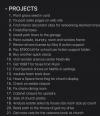Project R: Plant Rhododendron for wife.
You Write on Agenda for Wife:
Where to plant the Rhododendron?
You Write on Next Actions List/@Computer context:
Locate a store that sells Rhododendrons.
Next Actions List/@Computer context:
You learn that Lowes sells Rhododendrons.
Done.
You write on Next Actions List/@Errands context:
Buy Rhododendron at Lowes.
You stop for Today.
Four days from now:
Agenda for Wife: Where to plant the Rhododendron?
Wife says to plant the Rhododendron at X location.
Done.
Next Actions List/@Errands context
You buy the Rhododendron at Lowes.
Done.
Next Actions List/@Home Context:
You plant the Rhododendron at X location.
Done.
---------------------------------------------------------------------------------
Thank you,
@fooddude. I remember the Rhododendrons in Golden Gate Park long ago when I lived in San Franscisco. I love examples, especially ones about typical things around the house. It really clarifies how it works to have these details.
I think you want to point out that you have only one Next Action for a Project until you complete that Next Action. It is a little hard to see that because of not knowing exactly when things happened, but I get the idea.
I'm sorry I can't see the links you posted. Google won't let me see them unless I sign in. I see the photo, though, and you do have Project Support Folders (and nice bright colors). I am pretty sure I will need Projects folders.
I happened to find this article online from (I'm pretty sure) David Allen. It is a fortuitous find because it mentions the conditions under which we might have more than one Next Action for any Project.
Managing projects with GTD
Having a complete and current projects list is one of the cornerstones to GTD mastery.
To support you in getting there, here are 10 keys to defining and managing projects:
1. Projects are defined as outcomes that will require more than one action step to complete and that you can mark off as finished in the next 12 months.
2. Think of your Projects list as a current table of contents of the current outcomes on your plate.
3. Most people have 10-100 current projects, personally and professionally.
4. Current projects have at least one next action, waiting for, or calendar action, in order to be considered current.
5. Projects that have no current next action, waiting for, or calendar action are either no longer projects for you, or should be incubated to Someday/Maybe.
6. Future actions (i.e., actions that are dependent on something else happening first) do not go on the Next Actions lists until you can take action on them. They get stored with project plans.
7. The Projects list and project plans are typically reviewed in your GTD Weekly Review, ensuring each project has at least one current next action, waiting for, or calendar item.
8. It’s fine to have multiple next actions on any given project, as long as they are parallel and not sequential actions (e.g., “Buy stamps” and “Mail invitations” would not both be on Next Actions lists for the “Put on Party for David” project given that you need to buy the stamps before you can mail the invitations).
9. Projects are listed by the outcome you will achieve when you can mark it as done (what will be true?).
10. Effective project names motivate you toward the outcome you wish to achieve, and give you clear direction about what you are trying to accomplish.
###
Thanks, again.
Emily







